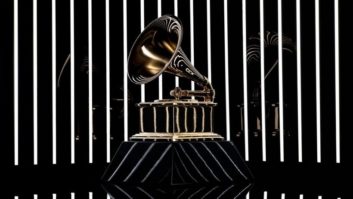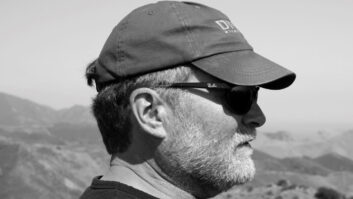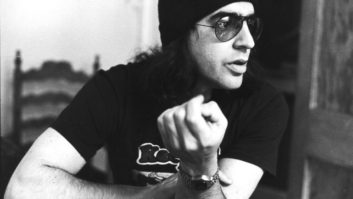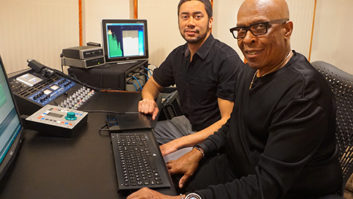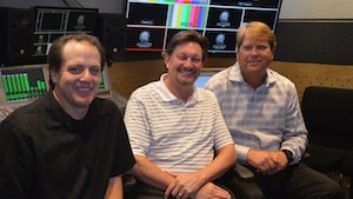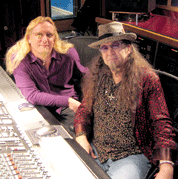
Way back — from the 1950s through the ’70s — it was common for record labels to operate their own recording facilities. Detroit’s Motown, CBS San Francisco, RCA Nashville, Memphis’ Stax and Sun, Chicago’s Chess, New York’s Atlantic — many of the studios where classic records were made were label-owned; recording in them was part and parcel of a record deal. But after The Beatles demonstrated the kind of big bucks pop music could generate, the industry changed. Artists gained more power and, along with it, the ability to choose where they would record. By the 1980s, independent commercial facilities were the norm, each vying for artists’ business with expensive equipment and pleasurable amenities. As commercial rooms thrived, label-owned studios closed, leaving very few in existence today, with EMI’s Capitol Studios in Los Angeles and Abbey Road in London among them.
Historically, commercial studios have tended to fall into two categories: those started by engineers or producers, and those owned by people with lots of disposable income who thought it would be fun to be in the music business. Either way, they were mostly labors of love, lacking both smart business plans and profits. Given that, along with the current music industry downturn and the rise of home-based digital recording, it’s no surprise that most of today’s commercial studios are struggling to stay afloat.
But even with high-quality home recording, there’s still a need for spaces in which artists can stretch out and/or hunker down to refine their music and sound. Real recording studios may be a smaller line item in current recording budgets, but they’re still an essential part of the creative process. Mix took a look around and found a lot of new models — and new models of old models — out there. Some are grass roots and personal, others are more sophisticated, harnessing both funding and business expertise from successful entrepreneurs outside of the music industry.
REINSTATING RECORD ROW
In Chicago, Blue Cactus Entertainment/Pressure Point Studios (www.pprecs.com) is located half a block from the former site of legendary Chess Records on what used to be called Record Row. “We want to capture that vibe and reference that energy,” says Blue Cactus managing director Chris Schneider. “Our dream is to bring a major-label presence to Chicago.”
“We’re back to an old-style production vibe, like Chess or Motown, but with better artist deals.”
–Chris Schneider
Blue Cactus is fitted with two very nice studios, but Schneider notes, “We never wanted to be strictly studio owners. We have artists signed to management and to our label. We started in the Latin market; now we’re branching out. We have a breakout urban artist that we think will be huge, a rock band and this year we’re focusing a lot more on artist development. That was a major part of our original business plan, but we needed our studios finished to do it.”
The principals in Blue Cactus are Schneider, a former musician and artist; multi-Platinum engineer/producer Larry Sturm; and cellular phone magnates Adrian Gerra and Daniel Bonilla. Open for six years, the company began as a production facility for DJ Paul Johnson. It soon became a more multifaceted business, including the operation of a commercial studio, but Schneider says, “We plan, with our artists and in-house producers, to be a private facility within the next 24 months. The way major labels are squeezing rates, the old commercial studio business model just can’t exist anymore.”
The label’s MO is, according to Schneider, more artist-friendly than labels of the past. “We partner with the producers and artists we sign,” he explains. “For example, there are mid-level urban artists who move, regionally, 20,000 to 50,000 units through an indie distributor. We may partner with a producer to provide ‘x’ amount of dollars in expertise and studio time, getting the distributor to ante up enough money to get the studio paid. We might also have a participation in sales. Every deal is different. Each one is an opportunity to figure out how we all can benefit.”
The company’s three-story building encompasses offices and production rooms, as well as the two studios. Both studios have multiple live recording spaces — all with different ambiences — including, Schneider notes, “a great-sounding drum room.” Rooms are wired so tracking spaces are available to smaller production rooms. There’s also a rehearsal room outfitted for live broadcast and video recording.
“We have a lot of different capabilities,” Schneider says. “We feel that we’re going full-circle, back to an old-style production vibe, like Chess or Motown, but with better artist deals. We want deals that benefit everyone and raise up all the ships so everybody gets more. Chicago has a lot of hot artists, from Kanye West and Twista to Disturbed, Billy Corgan and Chevelle. A lot of independent-minded people are doing exciting things here. Our goal is to help get Chicago the recognition it deserves as a real music center.”
REVIVING ARTIST DEVELOPMENT
In San Francisco, Tony Espinoza is attempting to blend art and commerce at SF Soundworks (www.sfsoundworks.com), a multiroom recording studio. A musician who double-majored at Stanford in music technology and computer engineering, Espinoza, along with two partners, was a founder of When.com, which, at the height of the tech boom, sold to AOL for a reported $225 million. As a VP of music services at AOL during its acquisition of Time Warner and its numerous record companies, he gained unique insight into the term “artist development.” Since then, Espinoza’s poured a lot of his dotcom earnings into SF Soundworks. His goal? To attract big-budget projects and use the revenues from them to subsidize recording sessions for promising local bands.
“What labels often mean by the term ‘artist development’ is actually audience development,” he comments, “the series of marketing procedures used to develop an artist’s audience. That’s very different than the production-oriented definition: taking an artist and coming out with a salable product. At Warner Bros., only really big records worked within the infrastructure. They owned a lot of cool, small labels, but they didn’t know how to deal with them. The small labels were essentially artist-driven, surviving on their own skill set and very few resources.
“The complaint ‘Major labels aren’t developing artists anymore’ really means they’re not investing in the early stages of an artist’s career, maybe below $500,000 in sales. They’re not investing in the artistic vitality of the artists. I realized that. It was also clear to me that, due to technology changes and the rise of digital production, both production and distribution costs were going to go through the floor, making it possible for artists to do a very different style of business. I decided that the interesting place to be was as close as possible to the artists.”
Unlike the others interviewed for this story, Espinoza has no plans to operate a label. “There are a lot of people doing that,” he explains. “I’m better at getting records made. Also, small labels tend to succeed when they’re closely associated with genres. If the label is too broad-based, it’s more likely to fail. I work on a pretty broad range of music; I’d have to have multiple labels, which isn’t practical.”

“What labels often mean by the term ‘artist development’ is actually audience development. That’s very different from the production-oriented definition.”
–Tony Espinosa
About the facility itself, an existing studio complex that Espinoza renovated, he says, “Studios today have to be very clear about what they’re offering and to excel at key things. I’m interested in live performance. I bought the space for the sound of its recording spaces and for the Studio A control room. Then I built a great live drum room.”
Although his official role is most often that of producer, Espinoza also acts as a facilitator, getting music noticed and recorded. “One of the best things I can do for people I work with is to help them develop the right team,” he comments, “a manager, a booking agent and a label who are excited about the project.
“I see the film world as a good model,” Espinoza concludes. “It’s adapted very well to a diverse kind of cultural expansion, with different kinds of media that appeal from the lowest common denominator to the highest. When I was dealing with big labels, their attitude was that the only way for them to make albums work was to shoot for the lowest common denominator. But the way I see it, the bigger the marketplace, the bigger the niches within it. Even 10 percent is huge on a global scale.”
COMMERCIAL MUSIC KINGS
Upstart label Three Kings Records (www.threekingsdbc.com) dropped its first release, the eponymous The Prom Kings, on January 18, 2005. After taking almost three years to come to fruition, by January 25, Three Kings had R&R magazine’s second most added rock radio cut. Now, gearing up for its second release (by female singer Jewlá, a former star of Miss Saigon and The Lion King), the company has taken over a studio complex in North Hollywood that houses two recording studios, production offices and a video editing suite.
Three Kings is made up of producer/writers Michael Carney and Andy Duncan and producer/engineer Csaba Petocz, along with CEO Zane Stoddard, former director of marketing for the NBA. Carney, the company’s upbeat founder and spokesperson, is, in no uncertain terms, out for commercial success. But like Blue Cactus’ Schneider, he brings an artist’s point of view to business.
“Andy and I started out making records in our bedrooms,” he explains. “But we always wanted to be able to work in great studios. With the current business climate, we thought the best way to do that was to have our own studio and use it for the artists we were developing. We wanted a professional facility where we could compete sonically, and where we could keep the rooms buzzing with acts we’re developing without worrying about the clock. We work through the day with the artists we’ve signed. On the night shift, we have young producers in here writing and recording. The studio isn’t a moneymaker; it’s a tool for the record company.”
Carney and Duncan originally financed the label and have also brought onboard a private investor. Like Blue Cactus, Three Kings offers artist-friendly deals. “There’s more overall participation for the artists than with a major-label deal,” Carney explains. “We look at our artists as their own company. We’re two companies coming together, starting with a fair deal.”
Carney cites his own experience as an artist on a major label spending almost $100,000 for production on one song. “There was no way I could ever recoup those costs, especially at the royalty percentage I was getting. Here, recording costs come out of the budget, but because of how the studios are used by different artists, costs get spread around and aren’t that high for any one artist.”
Carney sees video as integral to both the creative musical process and to the label. “We’re a production label,” he says. “Writing and producing music, shooting and directing a video — all of these things are creative tools to enhance the main profit center: the copyright. With audio and video production all under one roof, we don’t have to pay outside sources.”

“We look at our artists as their own company. We’re two companies coming together, starting with a fair deal.”
–Csaba Petocz
Carney isn’t worried about niche marketing; the artists on Three Kings are straight-up commercial, from the Prom Kings, who Carney describes as “Van Halen and Mötley Crüe meet Linkin Park,” to Jewlá and country artist Cody McCarver. “We’re not an art label. We tell our artists, ‘You have to give us something to sell.’ We’re not interested in selling 16 albums. We want to sell 16 million.”
So far, Carney says Three Kings has no desire to form a traditional partnership with a major label. “I’ve done that,” he explains. “I signed a production deal with a major and things immediately went from conviction to committee. Nothing was moving and everything got talked to death. It was frustrating. When we got out of that deal, we started our own company and put our own money in, until recently when we went looking for a successful businessperson — from outside the music business — who could provide us with financing and expertise, but who would stay separate from picking songs and talent.”
ARTISTICALLY FICTITIOUS
In contrast to the avowed commercialism of Three Kings, Nashville’s Fictitious Records (www.FictitiousRecords.com) is — according to owner (with partner Mike Davis) Roger Moutenot — proud to call itself an art label. Moutenot, an engineer and producer who’s worked with the likes of Yo La Tengo, Sleater Kinney and Lou Reed, points out, “One of the appeals of indie labels is that they can be artistic, allowing a band to really cultivate their music and their sound. With a major label, there’s more money going into the pot and more at stake, so there are more people stirring the pot. It’s a commodity game. Sometimes bands are into it, and if they’re lucky, they make a lot of money. Sometimes bands get totally frustrated by it and lose the concept of what they’re doing. To me, music is an art form. What I’m trying to do with our label is to allow our artists license to do what they really care to do without getting pigeonholed into any kind of genre.”
Founded two years ago, Fictitious now has 10 releases, including the most recent, We Also Create False Promises, by seven-piece instrumental band Character. Other projects range from vinyl 45s and EPs to full-length CDs with artists such as San Francisco’s Carrie Walker, Hoboken’s The Cucumbers and the first release by The Features (now signed to Geffen/Universal).
“My main business is producing and engineering,” Moutenot explains, “and I’ve always tried to find new acts to work with. One of them was Stone Jack Jones. He wasn’t on a label and his music is really off-the-cuff. I knew he’d have little chance of getting signed, so I decided to release the record myself. At the time, it was strictly Internet sales, but things grew. Now we have distribution with Morpheus and a promotion team backing us up, which has made a big difference.”

“One of the appeals of an indie label is they can allow a band to cultivate their music and sound.”
–Roger Moutenot
Moutenot produces the majority of the label’s releases; most of the music is recorded at his personal studio, which is housed in a 5,000-square-foot building. Because Moutenot prefers to have musicians perform in the same room with him, it has an extra-large 30×30-foot control room. A 2,000-square-foot live space is in the works, which will provide plenty of room for the gear and instruments, many of them vintage.
Fictitious may be growing, but it still operates on handshakes. Deals are usually for one record, with no contractual ties, and, after costs, a 50/50 split between label and artist. “We really do have a vision,” Moutenot emphasizes. “It’s artsy — eclectic, if you will — and pop. What touches people about music is more than what the lyrics say or how it rocks. It’s intangible. I believe, for a large majority of people out there, if something is honest, it’s going to ring true, touch people and find an audience.”
Maureen Droney is Mix’s L.A. editor.
